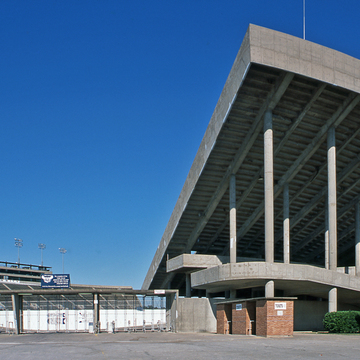With 70,000 seats, Rice's football stadium is the largest stadium in Houston and the most architecturally significant. It is a classic work of engineering modernism, constructed in nine months by industrial contractors Brown and Root, whose cofounder, George R. Brown, was then chairman of Rice's board of trustees. What passersby see are the upper seating decks of the stadium, raised high on extremely slender concrete columns. The lower seating decks and playing field were depressed into Harris Gully, a neighborhood bayou, to reduce excavation. The curving profiles of the decks figure against the breadth of the sky and the stadium's thirty-acre surface parking lot, which accommodates nearly seven thousand cars. Rice Stadium was rehabilitated in 2006.
On the south edge of the stadium parking lot, at the Stockton Street entrance to the university campus, lie two other architecturally significant but nonconforming Rice buildings: the Rice Media Center of 1970 and the Martel Continuing Education Center (formerly the Rice Museum) of 1969 by Howard Barnstone and Eugene Aubry, which were built by Dominique and John de Menil. Adjoining the Media Center and Art Barn is Reckling Park of 2000 by Jackson and Ryan, Rice's 3,000-seat baseball stadium.
Bridging the Rice campus and the Texas Medical Center at 6500 Main Boulevard is the ten-story Bioscience Research Collaborative of 2009 by Skidmore, Owings and Merrill of San Francisco, Perkins and Will, and FKP Architects. SOM's Craig Hartman designed the complex for biomedical research projects involving Rice and the institutions of the Texas Medical Center.









